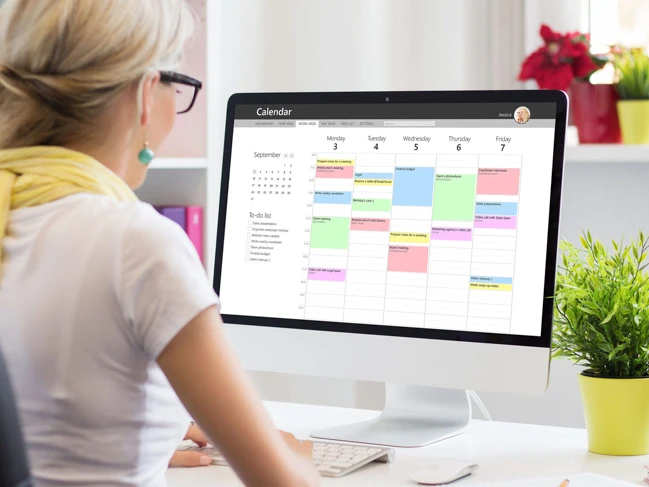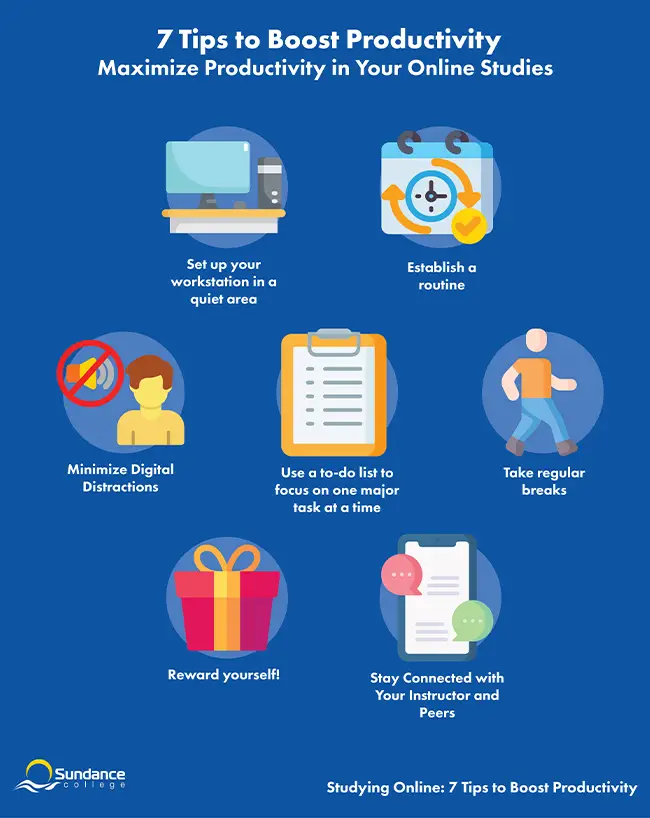Blog / Studying Online: 7 Tips to Boost Productivity
Studying Online: 7 Tips to Boost Productivity

Explore our Diploma Programs
- Business, Hospitality, and Legal
- Health and Human Services
- Technology
Table of Contents
The rise of remote learning has revolutionized the way we pursue education. Among other benefits that you can read about here, it offers the flexibility to adapt your learning schedule to your personal needs, improved study-life balance for many, and with a laptop in hand, you can study anywhere. Learning in an environment of your choice, at times that suit your schedule, has become a game-changer for many individuals juggling multiple responsibilities such as work and family commitments.
However, while offering greater flexibility for many, online studying may bring new challenges not seen in the classroom. Televisions, noisy household members and outside construction are usually problems found away from traditional learning environments that may impact your productivity when studying remotely.
Students often ask us, “How can I increase my productivity while studying online?” Fortunately, there are ways to address, work around or eliminate things that may hinder your productivity. In this blog article, we will explore seven of the best productivity techniques for effective remote studying, to help you maximize the benefits of this modern learning approach.
1. Set up your workstation in a quiet area
Designate an area in your house – or wherever you’re studying from. If you can, choose a room with a door that can be closed to minimize distractions and interruptions.
Of course, there will be family and friends within your home, for example, making noise as they go about their day, as well as disturbances from outside in urban areas, so the key is to minimize distractions – find a quiet space where you’re least likely to be distracted, and let everyone in your household know to not disturb you during your study time.
Organize your virtual learning space and customize it to suit you personally. One approach is to take organizational cues from dominant learning style, whether it is visual, auditory, or kinesthetic.
- Visual – If you can see it, you are likely to be distracted by it. So, make sure that your study area contains only what you need to see. Organize your space using shelves and storage containers with labels and color-code file folders. Display priority items on bulletin boards. To boost productivity, leave what you need to work on next time on your desk or leave a note stating, for example, “review family law case study”.
- Auditory – Your learning style will make you more prone to audible distractions, so have your headphones handy. Record your notes so you can listen to them later and set up sound notifications or alarms on your cell or computer to remind you that it’s time to study or time to take a break, for example. To boost your productivity, at the end of one study session, record what your objectives are for the next session and then listen to it the next day.
- Kinesthetic – As a hands-on learner, you may find yourself drawn to tangible objects around you that offer physical interaction. Use this to your advantage with tools to enhance your productivity. Use highlighters to color-code your reading material, a dry-erase board for your ideas and large post-it notes to jot down important points. To boost your productivity, consider having a standing desk or active seating options like an exercise ball or wobble cushion.
Removing distractions and working in a quiet area has benefits beyond increased productivity. Persistent loud noises can lead to stress, making it harder to focus. Quiet spaces free from distractions can maximise your brain’s attention on a project, helping you learn new skills and retain newfound knowledge.
Bonus tip: Scientists have discovered that indoor plants can boost productivity by up to 47%! Although the reasons behind the science are open to debate, plants can provide a calming effect by their smell and appearance while also giving our bodies an oxygen boost – much-needed during Canada’s coldest months!

2. Establish a routine
As an online learner, you have the flexibility to schedule that can fit around your personal and work life. To take advantage of that, you need to establish a routine.
A routine helps you deal with distractions and boost productivity. Much like a workstation, routines can be personalized to suit personal or professional commitments – there is no one-size-fits-all structure with this one!
Set a consistent study schedule that aligns with your peak productivity times, if possible. By establishing a routine, your mind will adapt to the designated study hours, making it easier to concentrate and resist distractions. Of course, personal and professional commitments may take up some of your time, and sometimes these are unavoidable. If so, schedule these priorities so that you can find gaps in your day to focus on virtual learning.
Studying with kids at home can present additional challenges. Establishing schedules, dedicated study space – and noise-cancelling headphones – can help you balance studying and taking care of your children. Studying with babies at home adds a new complexity but you can adapt, for example, by taking advantage of their frequent naps to get your coursework done.
Routines organize overwhelming everyday tasks into simple, manageable goals which can seem easier to accomplish. By prioritizing specific tasks throughout the day, you’re able to split your day up and ensure you’re able to complete all your ‘must dos’ before you close the computer for the evening. They’re particularly useful for students with other obligations, from work to picking up loved ones from work or school.
How you organize your routine is ultimately down to personal preference, but whatever yours is, stick with it!
3. Minimize Digital Distractions
Even if you have eliminated all audible distractions, you still need to clear your workstation of any visual distractions.
As a rule, phones, tablets and games consoles don’t have a place in your study station. If you require a phone or tablet to complete part of your learning, ensure that it is set to ‘do not disturb’ to avoid distracting notifications, which can take away your focus on a task and reduce your productivity. Many modern devices feature ‘focus mode’, allowing you to close distracting applications such as social media or messaging services if you require your phone for learning or emergencies.
Some students like to listen to music when they work. If you feel more productive listening to music, then enjoy some of your favourite artists or albums while you study. However, if you find yourself paying more attention to the lyrics than your work itself, consider removing the device from your workstation.
Electronics such as a fan, lamp or clock are generally distraction-free. Of course, if your fan is noisy or your lamp flickers, then it could be worth looking for replacements.
If you’re unsure whether to include an electronic device as part of your workstation, remember this: the less it does, the less it distracts!
4. Use a to-do list to focus on one major task at a time
In the fast-paced world we live in, managing multiple responsibilities and staying organized can often feel overwhelming. That’s where the power of a to-do list comes in. Creating a well-structured and thoughtfully prioritized to-do list is like having a personal productivity coach guiding you through your day and is often the difference between a good student and a great student.
By jotting down tasks, deadlines, and goals, you gain a clear overview of what needs to be accomplished and can focus your energy on the most important and time-sensitive activities. The beauty of a to-do list lies in its ability to help you prioritize effectively, enabling you to make informed decisions about where to invest your time and effort. Allocate tasks according to urgency, importance, and personal preferences to help you tackle your workload with purpose, boost efficiency, and achieve your goals.
Your list does not need to be overly detailed – rank your tasks by order of importance and check them off when completed! When you cross off a task to signify you’ve completed it, your brain releases dopamine which causes positive feelings such as happiness and pleasure and boosts motivation. It also fuels your productivity because we long for that feeling again.
A to-do list can help you break up a large project into smaller, more achievable chunks. One such method to help with this is the 1/3/5 technique, where you split your to-do list by focusing on one large project, followed by three medium-sized ones, and finally five smaller tasks. Using this method, you would prioritize your largest task for the day, and then move on to smaller, less significant objectives. This can help boost your productivity by focusing on the most important aspects first.
Whether you prefer a traditional pen-and-paper approach or embrace the digital age with task management apps, the beauty of to-do lists lies in their simplicity and adaptability. Embrace the power of organization and take control of your productivity journey.

5. Take regular breaks
A common misconception is that studying more hours throughout the course of a day leads to greater productivity. However, if you’re planning to study more than two hours, you should consider taking breaks throughout your session.
A 2021 study found that “waking rest” (taking breaks) influences successful learning. Skill memory is enhanced when separated by breaks, according to the study, compared to when you try to complete tasks without time to consolidate on your learning. Our brains bind together what we learned during these breaks, leading us to acquire new skills faster than previously expected12.
There are several ways you can address taking breaks. A common approach is the 20/20/20 method, where, every 20 minutes, you stare at an object 20 feet away for 20 seconds. This helps reduce eyestrain, particularly important when remote studying as it helps our eye muscles relax during prolonged periods of screentime, meaning we’re able to focus better during the course of a day.
Another popular method is the Pomodoro Technique. The Pomodoro (Italian for ‘tomato’) was invented in the 1980s by Francesco Cirillo, who used his tomato-shaped kitchen timer in developing a system to improve productivity by breaking work into intervals. The process is simple: for every 25 minutes of work or study, take a five-minute break. Repeat three more times before enjoying a longer break of 15-30 minutes.
Try different methods to see what works best for you.

6. Reward yourself!
In the pursuit of productivity, it’s easy to get caught up in the never-ending cycle of work without taking a moment to appreciate the progress made. What you may not know, is that incorporating rewards for yourself can have a profound impact on your motivation, focus, and overall productivity.
Rewards give you something to look forward to, they break up the monotony, and recharge your mental and emotional energy. Moreover, rewards help to cultivate a healthy work-life balance, preventing burnout and promoting well-being. For your next study or assignment session, decide in advance what your reward will be for getting it done. The reward should be something you particularly enjoy, whether that’s a walk in your nearby park, a bike ride or a nap. Or you may wish to treat yourself to your favourite snack or buy a new shirt you’ve wanted for a while.
Some students prefer to keep their rewards for the end of the day. This delayed gratification builds up resilience and determination to keep going, as you know there will be an immediate reward after a hard day’s study. The wait, combined with the feeling of a productive day, leads to an even greater sensation of satisfaction when all is said and done.
So, the next time you sit down to study, remember to schedule rewards for yourself. Celebrate your accomplishments, both big and small, and embrace the positive impact it has on your motivation, productivity, and overall success.
7. Stay Connected with Your Instructor and Peers
When it comes to navigating higher education, your college is more than just a place of academic instruction—it has many valuable resources and a supportive community. Students often overlook the power of reaching out to their college, but doing so creates opportunities in addition to promoting your productivity.
Students at Sundance College start their program with a class to help make the transition to post-secondary learning and set them up for success. Class topics include different learning styles, goal setting, note-taking, successful test-taking, and more, so you know you will be in safe hands when it comes to furthering your career.
As well, Sundance College’s instructors are available to provide assistance and guidance. They can offer support on challenging projects and offer insight as to the best approaches to what you are working on. In short, their roles stretch above and beyond the confines of the classroom.
A recent graduate, Levi M. said: “My instructor was always available – whenever I asked, he was really fast in answering which was brilliant.”
“It’s kind of like going to the gym. You can go to the gym, start off on your course to get fit, but there are times that you won’t be able to do it. That’s why you need a personal trainer who can tailor a program for you to motivate you and support you when you achieve something.”
If you are considering becoming a student at Sundance College, visit our website and fill in our Request Info form to learn more about how we are here to support our students on their journey to a new career and a brighter future.
Subscribe for more career advice
Blog Categories
Share on:
